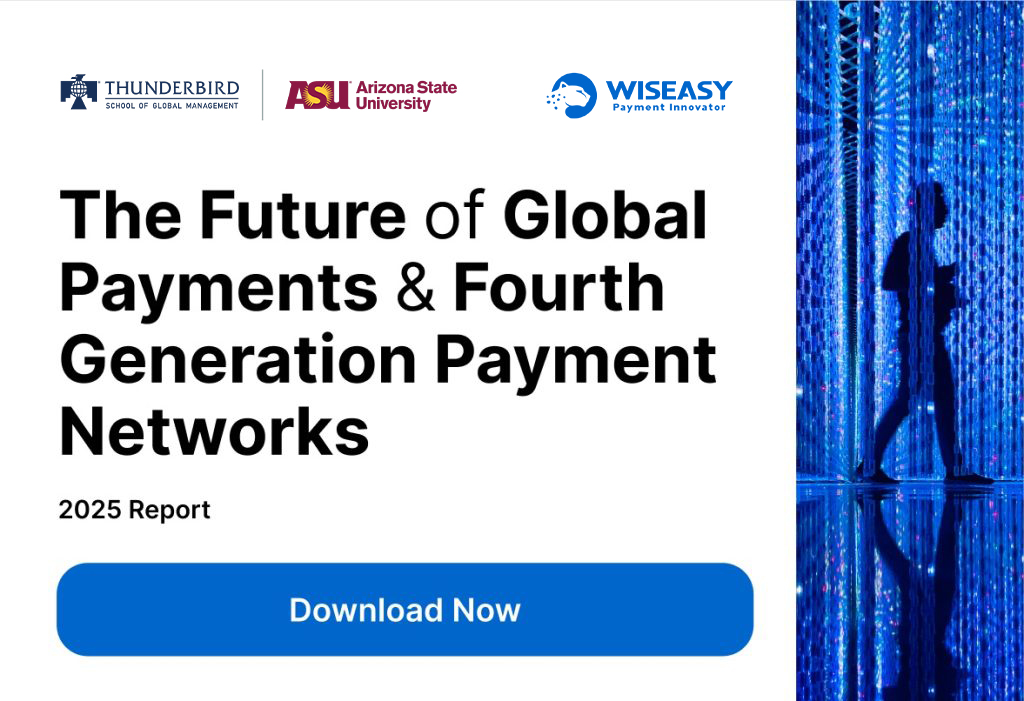Fourth Generation Payment Networks: The next frontier in global payments
Media07 Jul 2025

The global payments landscape is undergoing a profound transformation, marked by the emergence of Fourth Generation Payment Networks (4GPN).
A new whitepaper by Thunderbird School of Global Management and Wiseasy outlines how these networks could redefine financial services worldwide.
4GPN
 According to The Future of Global Payments & Fourth Generation Payment Networks (4GPN), the digital payments market is forecast to grow from $10.18 trillion in 2024 to over $32 trillion by 2033, driven by fintech innovation, regulatory initiatives, and shifting consumer expectations.
According to The Future of Global Payments & Fourth Generation Payment Networks (4GPN), the digital payments market is forecast to grow from $10.18 trillion in 2024 to over $32 trillion by 2033, driven by fintech innovation, regulatory initiatives, and shifting consumer expectations.
At the heart of this evolution lies 4GPN – integrated infrastructures combining IoT, blockchain, cloud computing, biometrics, and digital currencies into a unified platform capable of supporting both banked and unbanked populations.
Unlike earlier payment network generations, which operated within siloed systems, 4GPN offers a holistic approach.
They integrate traditional card networks, digital wallets, biometric recognition, and decentralised currencies, enabling seamless transactions across mobile apps, online platforms, and physical points of sale.
For merchants and financial institutions, this presents opportunities to streamline payments infrastructure, improve operational efficiency, and reduce transaction costs.
Financial Inclusion
Critically, 4GPN promises to advance financial inclusion.
With 1.7 billion adults globally remaining unbanked, yet 1.1 billion owning mobile phones, mobile-first interoperable networks can bridge access gaps by enabling secure, real-time payments even in regions lacking formal banking infrastructure.
This holds significant promise for economic development across emerging markets.
The report also highlights the transformative role of AI in fraud prevention, as real-time pattern analysis becomes essential in a digital ecosystem where transaction volumes and velocity continue to rise.
Simultaneously, the growth of account-to-account (A2A) payments, central bank digital currencies (CBDCs), and embedded finance is reshaping how money moves within and across borders.
Amongst Opportunities Lie Challenges
However, alongside these opportunities lie challenges.
Effective regulation remains critical to ensuring consumer protection and systemic stability, particularly as digital currencies and decentralised finance models gain traction.
Furthermore, robust data privacy frameworks will be essential to underpin trust in biometric and AI-enabled payment solutions.
Wiseasy, a co-author of the whitepaper, envisions 4GPN as a strategic foundation for an inclusive, scalable, and interoperable global payments ecosystem.
As governments and private sector innovators align on digitalisation strategies, 4GPN could become the backbone enabling cashless economies to thrive sustainably.
Ultimately, Fourth Generation Payment Networks represent more than a technological upgrade; they are a structural shift towards an integrated payments architecture capable of powering the next era of global commerce.
For payment providers, policymakers, and merchants alike, understanding and investing in this paradigm shift will be key to remaining competitive in an increasingly digital and borderless economy.
Download the full whitepaper today and discover how Fourth Generation Payment Networks (4GPN) are setting the new standard for accessible, intelligent, and inclusive finance.
Source: PCM











